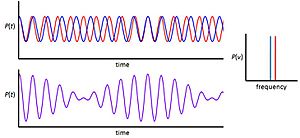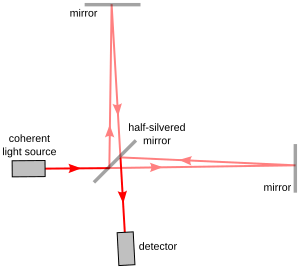Time-domain spectroscopy facts for kids
Time-domain spectroscopy is a special way to study light and other types of energy waves. Imagine you have a song. Normal spectroscopy is like looking at the notes (frequencies) in the song. Time-domain spectroscopy is like listening to the song as it plays over time. It measures how strong the energy waves are at different moments.
Most of the time, when scientists study light, they look at its frequency or wavelength. This is called frequency-domain spectroscopy. But sometimes, it's more helpful to see how the energy changes over time. This is what time-domain spectroscopy does. It often uses a special math tool called a Fourier transform to switch between looking at things by time or by frequency.
When two waves of light meet, they can create patterns. This is called interference. If the waves line up perfectly, they make each other stronger. This is called constructive interference. It creates a big peak. If they are opposite, they cancel each other out. This is called destructive interference. It creates a low point.
Imagine two different colored lights. In frequency-domain, you would see them as two separate lines. In time-domain, you would see how their combined wave changes over time. The picture above shows how two waves can add up to make a new pattern over time.
Sometimes, when light is absorbed, it creates a wide peak in a spectrum. This means many different wavelengths of light are involved. When you plot these many wavelengths in the time domain, the patterns of constructive interference become smaller. This happens because the waves, being very close in wavelength, quickly get out of sync with each other.
How Scientists Get Time-Domain Spectra
Light waves, like visible light or infrared light, vibrate incredibly fast. They can vibrate trillions of times per second! Our normal tools, called phototransducers, can't measure things that quickly. They are like slow-motion cameras trying to catch a speeding bullet.
So, scientists need a clever way to slow down these super-fast signals. For studying light, especially infrared light, they often use a device called a Michelson interferometer.
Here's how a Michelson interferometer works:
- A beam of light enters the device.
- A special mirror, called a beam splitter, divides the light into two separate beams.
- Each beam travels to a different mirror.
- The beams reflect off these mirrors and come back to the beam splitter.
- One of the mirrors can move back and forth.
- When the two mirrors are exactly the same distance from the beam splitter, the two light beams meet up perfectly. They combine and make a strong signal (constructive interference).
- As the movable mirror slowly moves, the path length for one beam changes. This makes the two beams slightly out of sync when they meet.
- When the movable mirror has moved just a tiny bit (one-quarter of the light's wavelength), the beams will be completely out of sync. They will cancel each other out (destructive interference).
- By moving the mirror and measuring the light's strength, scientists can see how the light changes as a function of the mirror's distance. Since they know how fast the mirror is moving, they can then figure out how the light's strength changes over time.
Most time-domain spectroscopy experiments use broadband radiation. This means they use light that has a wide range of different wavelengths, not just one single color.
What Time-Domain Spectroscopy is Used For
Time-domain spectroscopy is very useful in many areas of science. It's especially important in:
- Infrared spectroscopy (often called FT-IR)
- NMR spectroscopy (often called FT-NMR)
It has some big advantages over the older frequency-domain methods:
- Faster measurements: In frequency-domain experiments, scientists often have to measure each wavelength of light one by one. This can take several minutes. Time-domain experiments are much quicker, usually taking only a few seconds.
- Better results: Because time-domain experiments are so fast, scientists can repeat the measurement many times for the same sample. They can then average all these measurements together. This helps to get a clearer signal and remove any unwanted "noise" or errors from the data. So, the results are not only faster but also more accurate.




